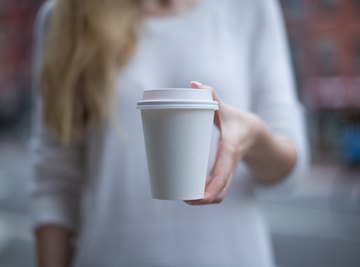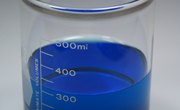
A calorimeter is a device used to measure the heat energy released or absorbed in a chemical reaction. A coffee-cup calorimeter is a type of reaction calorimeter that uses a closed, insulated container for making heat measurements, easily made from supplies at home. Coffee cups, especially those made of Styrofoam, are effective calorimeters because they hold in the heat.
- Styrofoam cup
- Cardboard
- Lab thermometer
- Plastic stirrer
- Clamp or ring stand
To use the calorimeter, place a liquid in the coffee cup and take its initial temperature. Add a reactive substance to the liquid, such as creamer if using coffee and, as the reaction takes place, take periodical measurements from the thermometer. The amount of heat released or absorbed can be calculated according to the equations for heat flow and specific heat. For additional insulation, you can use two coffee cups, one inside the other and a tight-fitting plastic lid.
Make a cardboard lid. Cut or separate a piece of cardboard large enough to completely cover the mouth of the Styrofoam cup. The lid should be flat and make a good seal when placed inside the lip of the cup. Cardboard acts as a better insulator than plastic lids do.
Poke a hole in the center of the cardboard lid large enough to fit the laboratory thermometer. The fit should be snug, though, so no heat will escape through the hole. Insert the thermometer far enough through the lid so the sensitive end will reach near the bottom of the coffee cup and the temperature can be read from the opposite end.
Cut a small hole for a stirring rod through the lid to one side of the thermometer. Insert the stirring rod and verify it fits snugly, but has enough range of motion to stir. To keep the chemical reaction going, it might be necessary to stir the combination in the coffee cup.
Pour hot coffee or some other hot liquid into the cup.
Set the cardboard lid into the coffee cup. Stir the contents and take the measurement using the thermometer.
Things You'll Need
Tips
Tips
- To use the calorimeter, place a liquid in the coffee cup and take its initial temperature. Add a reactive substance to the liquid and, as the reaction takes place, take periodical measurements from the thermometer. The amount of heat released or absorbed can be calculated according to the equations for heat flow and specific heat (see Resources below). For additional insulation, you can use two coffee cups, one inside the other and a tight-fitting plastic lid.
About the Author
Joseph Nicholson is an independent analyst whose publishing achievements include a cover feature for "Futures Magazine" and a recurring column in the monthly newsletter of a private mint. He received a Bachelor of Arts in English from the University of Florida and is currently attending law school in San Francisco.
